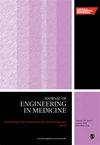A novel design of hip-stem with reduced strain-shielding
IF 1.5
4区 医学
Q3 ENGINEERING, BIOMEDICAL
Proceedings of the Institution of Mechanical Engineers, Part H: Journal of Engineering in Medicine
Pub Date : 2024-04-22
DOI:10.1177/09544119241244537
引用次数: 0
Abstract
The use of uncemented stems in hip arthroplasty has been increasing, even in osteoporotic patients. The major concerns of uncemented hip-stems, however, are peri-prosthetic fracture, thigh pain, and proximal femoral stress-/strain-shielding. In this study, a novel design of uncemented hip-stem is proposed that will reduce such concerns, improve osseointegration, and benefit both osteoporotic and arthritic patients. The stem has a central titanium alloy core surrounded by a set of radial buttresses that are partly porous titanium, as is the stem tip. The aim of the study was to investigate the mechanical behaviour of the proposed partly-porous design, examining load transfer in the short-term, and comparing its strain-shielding behaviour with a solid metal implant. The long-term effect of implant-induced bone remodelling was also simulated. Computed tomography based three-dimensional finite element models of an intact proximal femur, and the same femur implanted with the proposed design, were developed. Peak hip contact and major muscle forces corresponding to level-walking and stair climbing were applied. The proposed partly-porous design had approximately 50% lower strain-shielding than the solid-metal counterpart. Results of bone remodelling simulation indicated that only 16% of the total bone volume is subjected to reduction of bone density. Strain concentrations were observed in the bone around the stem-tip for both solid and porous implants; however, it was less prominent for the porous design. Lower strain-shielding and reduced bone resorption are advantageous for long-term fixation, and the reduced strain concentration around the stem-tip indicates a lower risk of peri-prosthetic fracture.减少应变屏蔽的新型髋关节茎干设计
髋关节置换术中使用非骨水泥柄的情况越来越多,即使是骨质疏松患者也不例外。然而,非骨水泥髋关节柄的主要问题是假体周围骨折、大腿疼痛和股骨近端应力/应变屏蔽。本研究提出了一种新颖的非骨水泥髋关节置换髋关节置换髋关节柄的设计方案,该方案可减少上述问题,改善骨结合,使骨质疏松和关节炎患者受益。该髋臼茎干有一个中央钛合金核心,周围是一组径向支撑,部分是多孔钛,茎干顶端也是如此。研究的目的是调查所建议的部分多孔设计的机械性能,检查短期内的载荷传递,并将其应变屏蔽性能与实心金属植入物进行比较。此外,还模拟了植入物引起的骨重塑的长期影响。基于计算机断层扫描技术,建立了完整股骨近端和植入拟议设计的同一股骨的三维有限元模型。应用了与平地行走和爬楼梯相对应的髋关节接触峰值和主要肌肉力。拟议的部分多孔设计的应变屏蔽比固态金属设计低约 50%。骨重塑模拟结果表明,只有 16% 的骨总量受到骨密度降低的影响。在固态和多孔植入体的柄尖周围骨质中都观察到了应变集中现象,但多孔设计的应变集中现象并不明显。较低的应变屏蔽和较少的骨吸收有利于长期固定,而柄尖周围应变集中的减少表明假体周围骨折的风险较低。
本文章由计算机程序翻译,如有差异,请以英文原文为准。
求助全文
约1分钟内获得全文
求助全文
来源期刊

CiteScore
3.60
自引率
5.60%
发文量
122
审稿时长
6 months
期刊介绍:
The Journal of Engineering in Medicine is an interdisciplinary journal encompassing all aspects of engineering in medicine. The Journal is a vital tool for maintaining an understanding of the newest techniques and research in medical engineering.
 求助内容:
求助内容: 应助结果提醒方式:
应助结果提醒方式:


